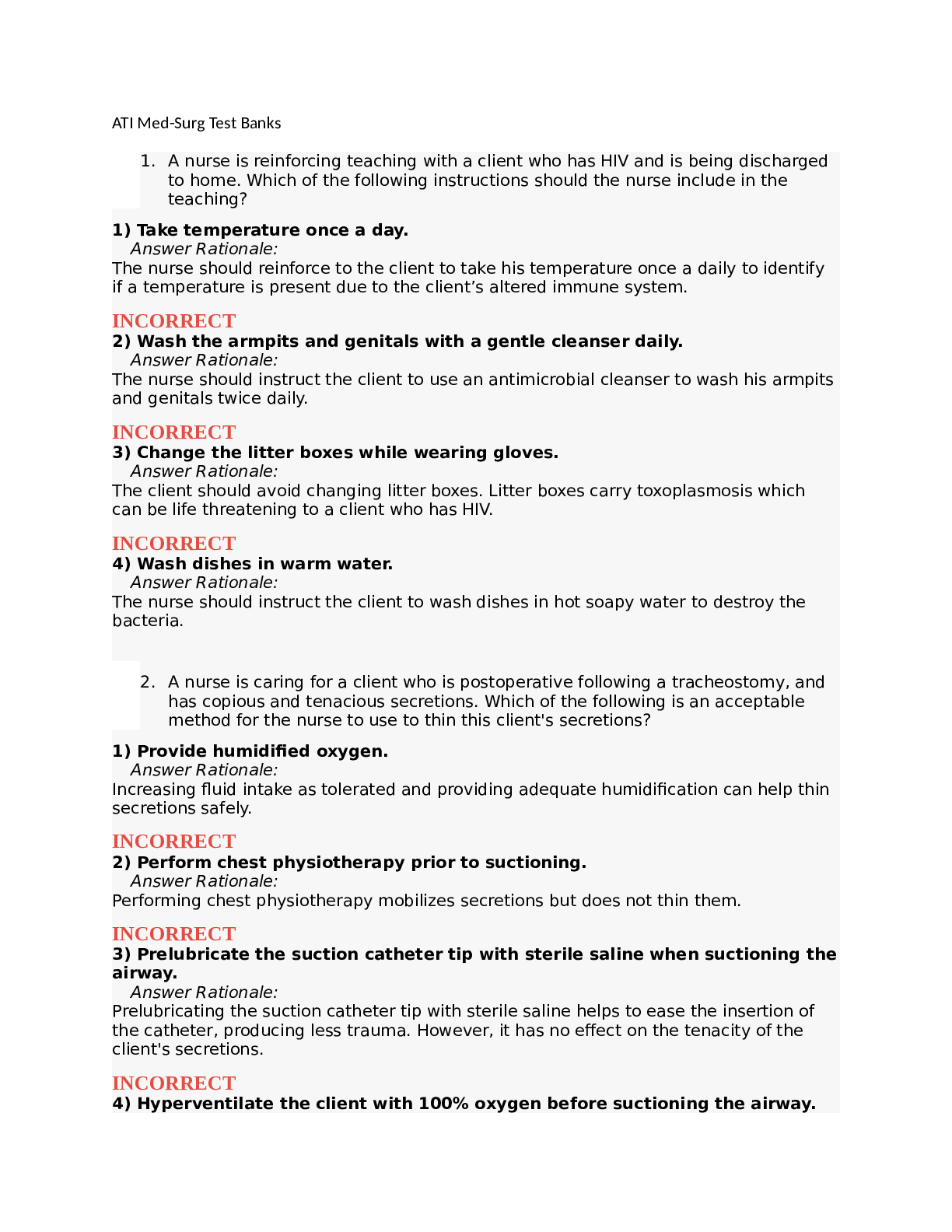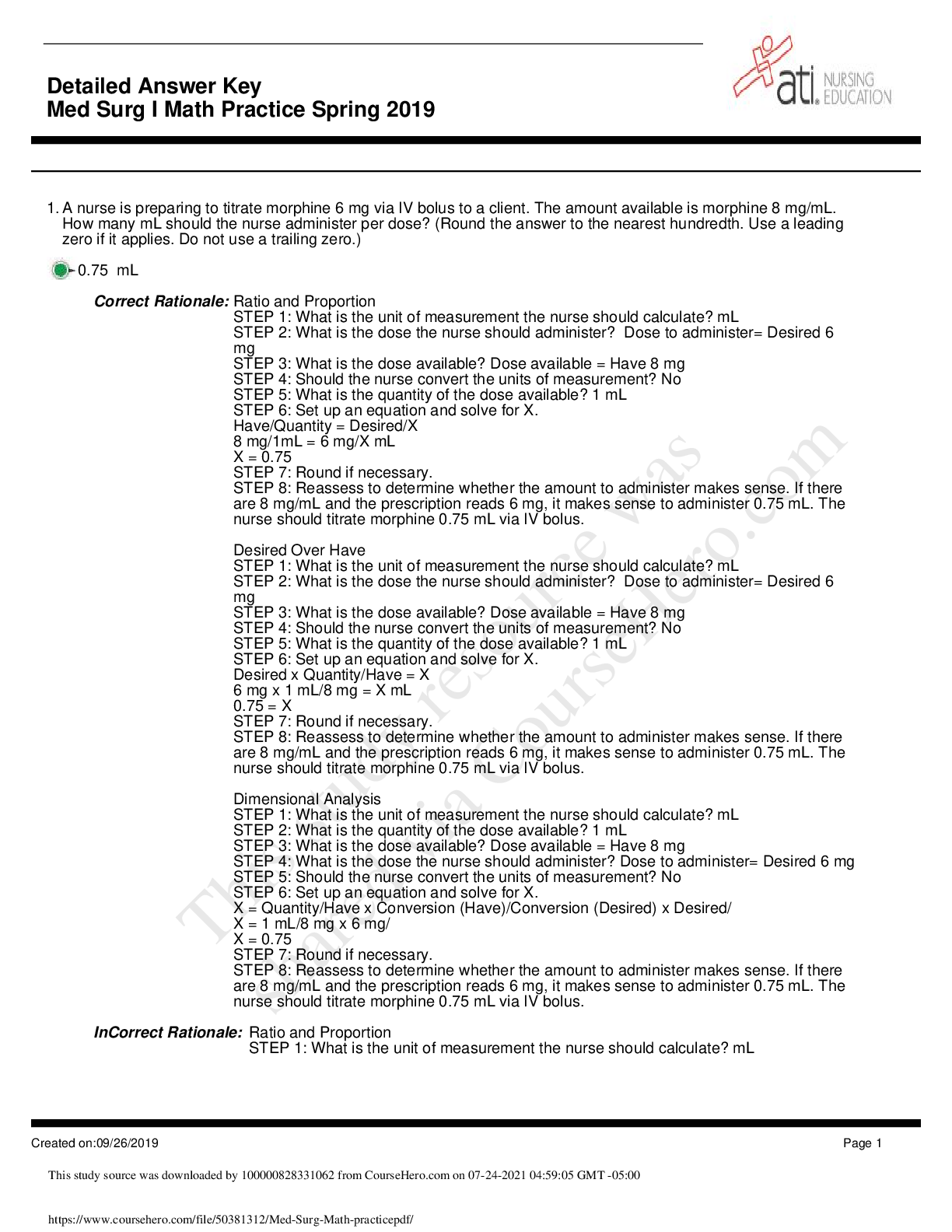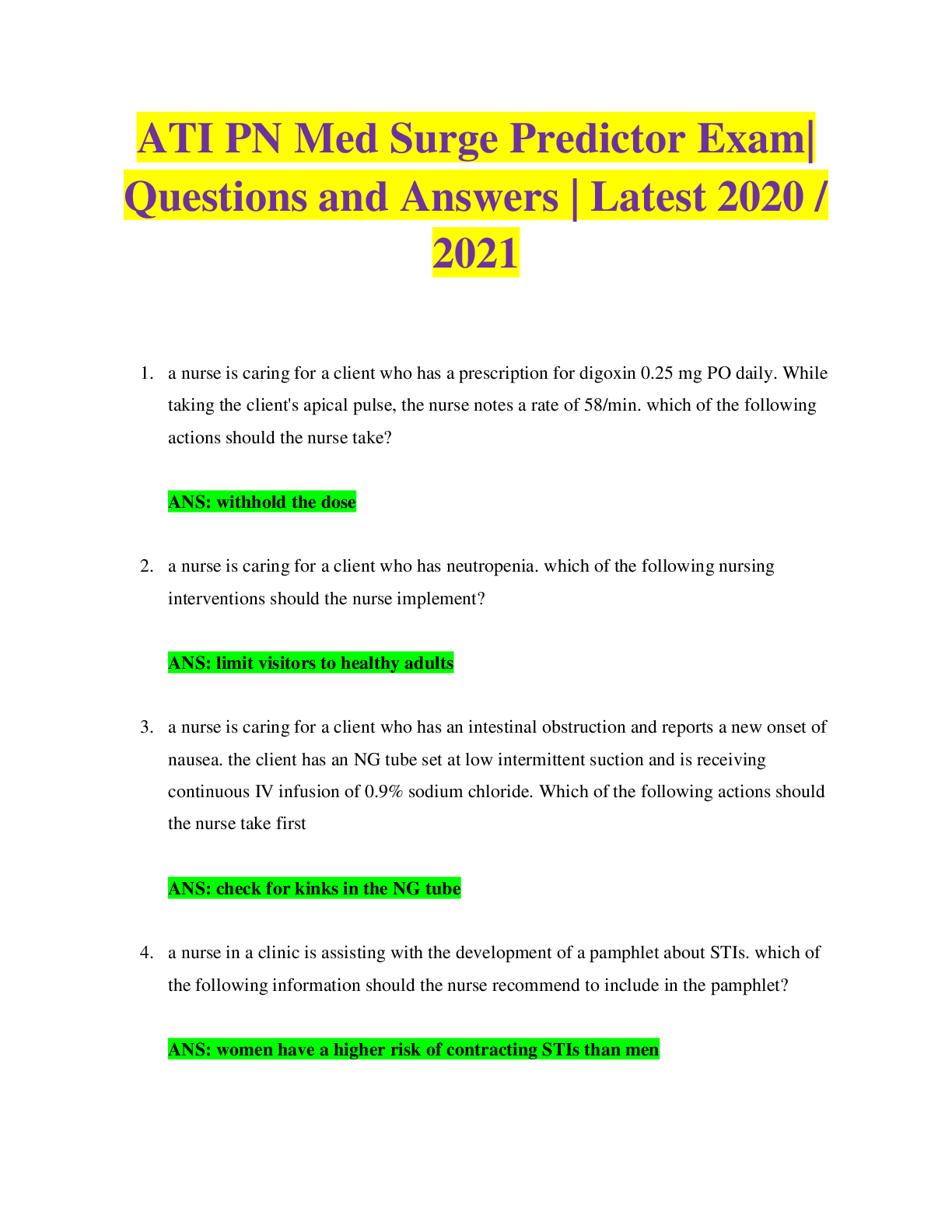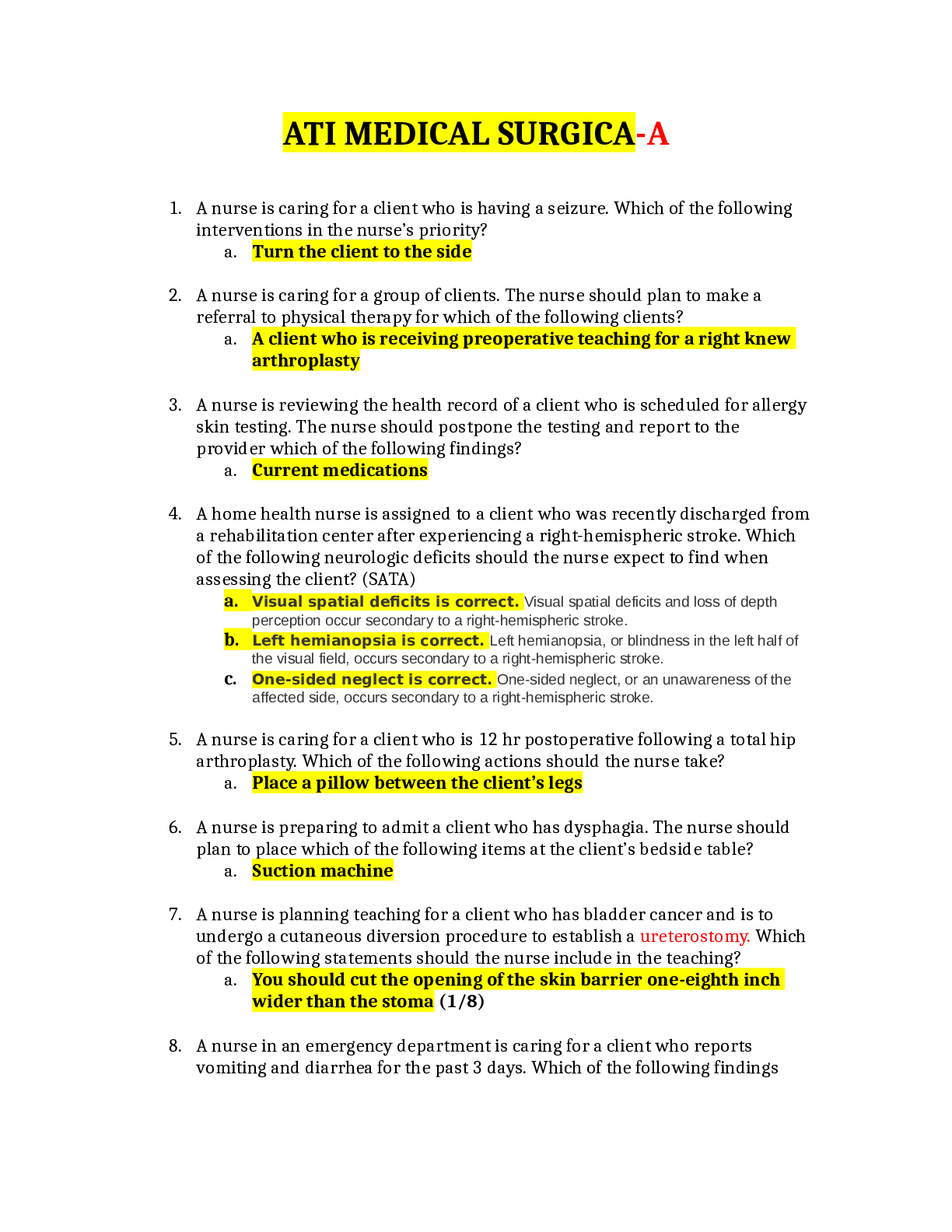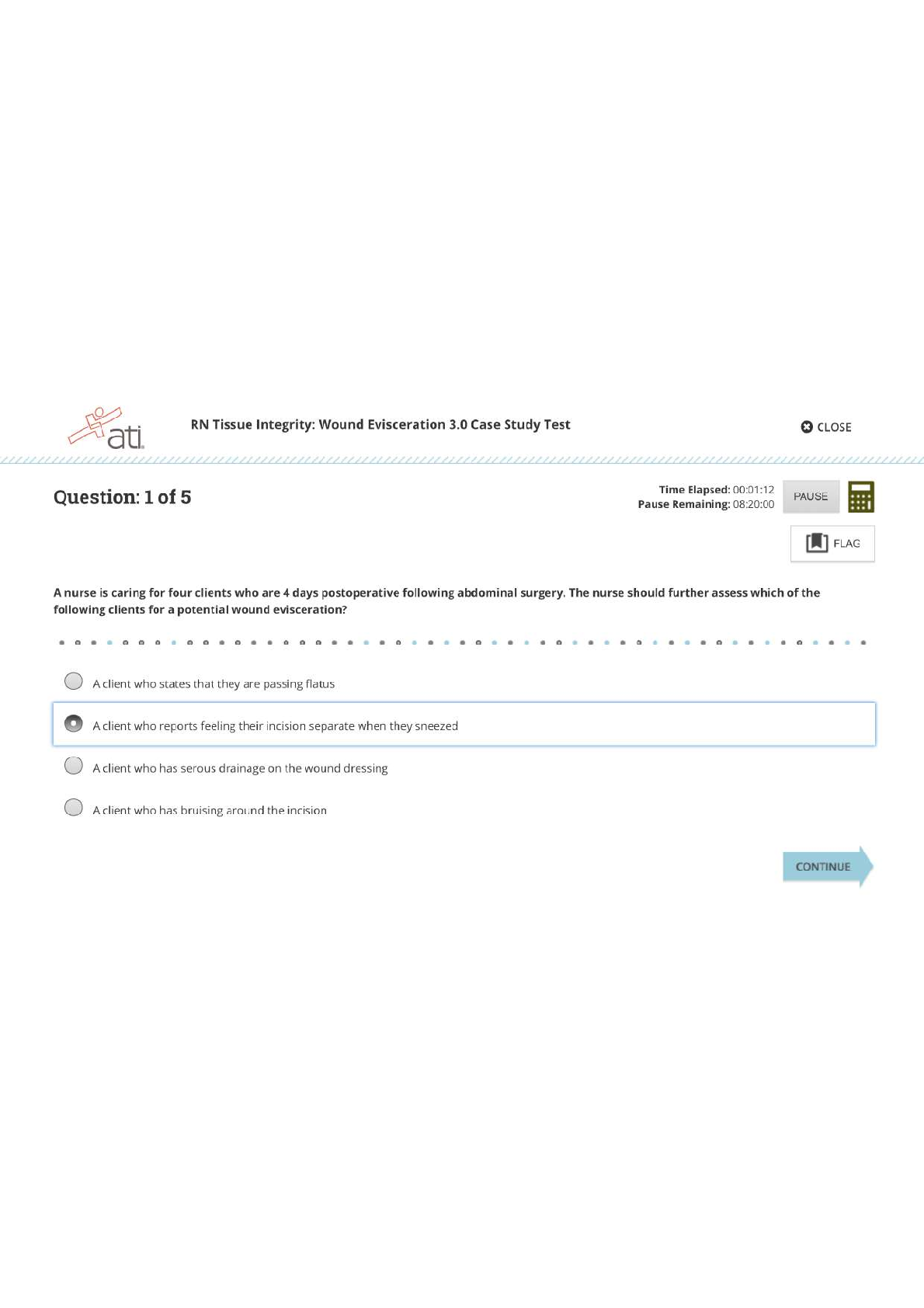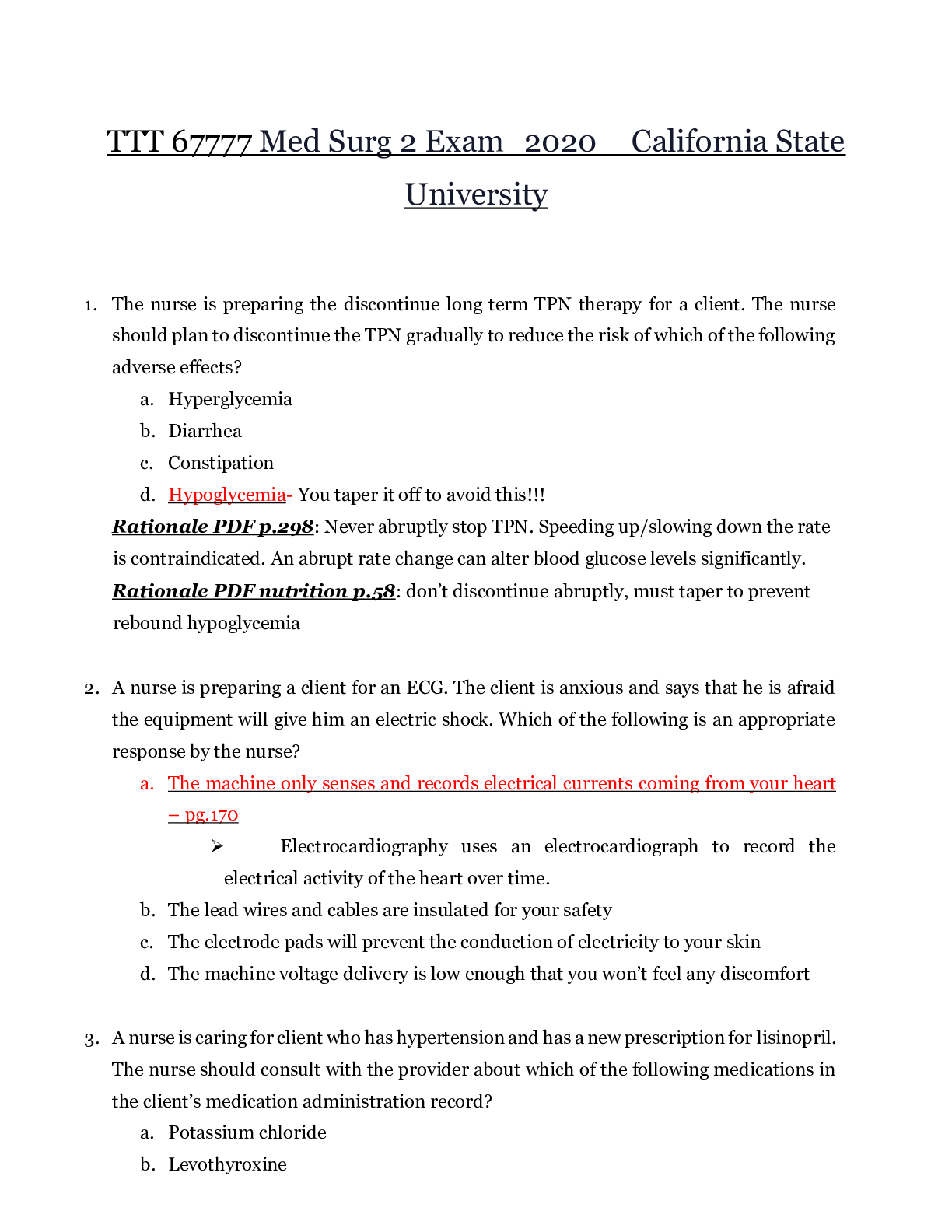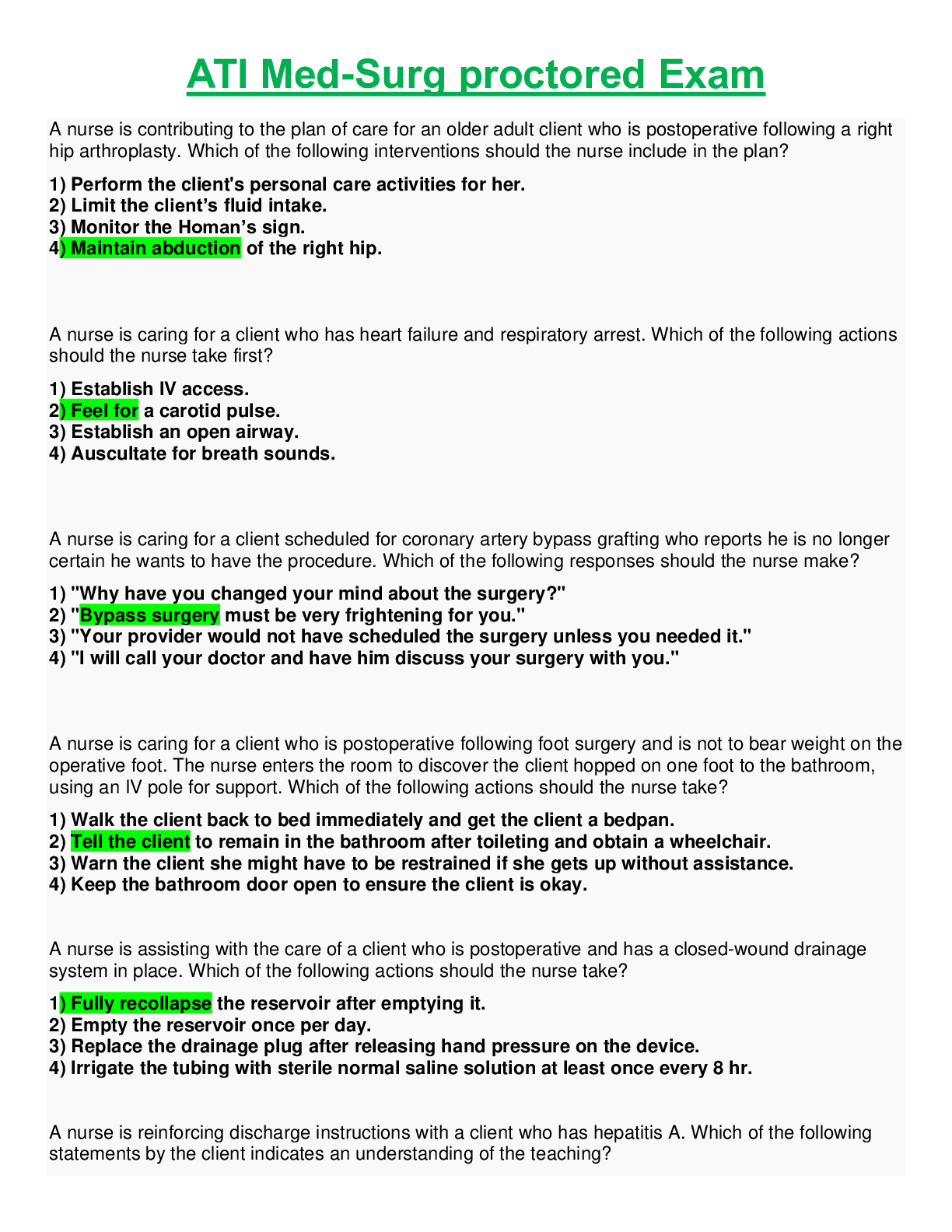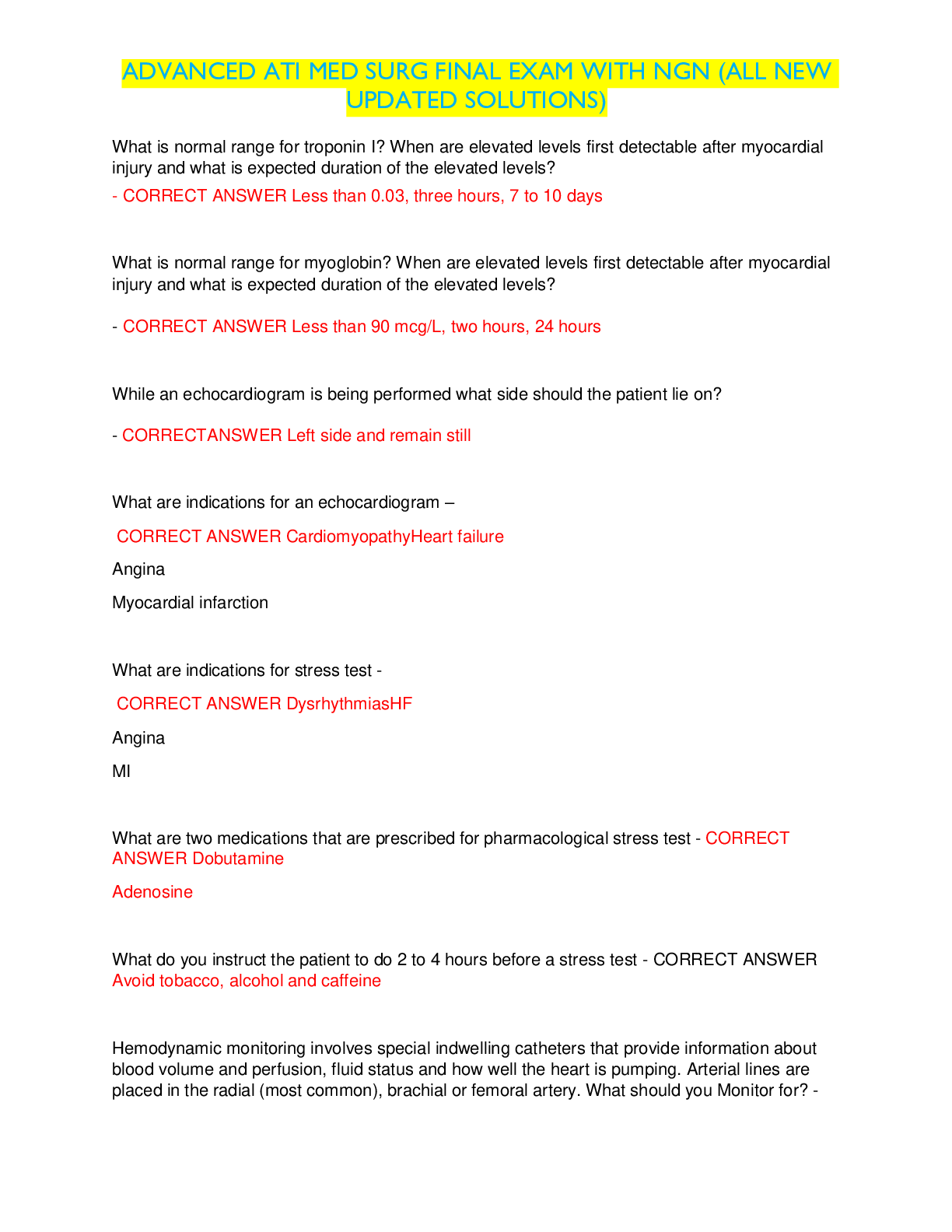*NURSING > ATI MEDICAL SURGICAL > Rasmussen College: medsurg_Latest,100% CORRECT (All)
Rasmussen College: medsurg_Latest,100% CORRECT
Document Content and Description Below
Rasmussen College: medsurg_Latest A charge nurse is delegating a task. The nurse understands which of the following represents effective delegation? Select all that apply. Select one or more: a. ... Asking the nurse if they are capable of completing the delegated task. b. Delineating the desired outcomes of the delegation. c. Referring to the ANA Code of Ethics for effective delegation practices. d. Monitoring how the delegated task is being accomplished. e. Delegating a task that should be assigned to a manager. abd - Asking the individual who is being delegated if they are capable of completing the delegated task is considered effective delegating. Identifying the qualified person best able to complete the job in terms of capability and time to do so is considered effective delegation. - Effective delegation means planning ahead when identifying tasks to be accomplished. Assess the situation, and clearly delineate the desired outcomes. - Monitoring how the task is being accomplished is considered effective delegating. A nurse is aware that priorities need to be continuously set and reset in order to meet the needs of multiple clients. Which principles of client care should the nurse use for prioritization when giving report? Select all that apply. Select one or more: a. Prioritize systemic before local. b. Prioritize potential problems before actual. c. Prioritize acute before chronic. d. Recognize and respond to transient findings. e. Listen carefully and don't assume. ace - Prioritizing systemic before local ("life before limb") is a prioritization principle in client care. Examples include prioritizing interventions for a client in shock over interventions for a client with a localized limb injury. - Prioritizing acute (less opportunity for physical adaptation) before chronic (greater opportunity for physical adaptation) is a prioritization principle in client care. Examples include prioritizing the care of a client with a new injury/illness (e.g., mental confusion, chest pain) or an acute exacerbation of a previous illness over the care of a client with a long-term chronic illness. - Listen carefully and don't assume is a prioritization principle used in client care. Recognizing that a postoperative client's report of pain could be due to pain in another location rather than expected surgical pain. A nurse is obtaining a sterile specimen from an indwelling urinary catheter. Place the following steps in the order the nurse should use to obtain this specimen: A. Remover clamp to resume drainage. B. Drain the cathether's tubing of urine. C. Place urine sample in sterile container. D. Clamp the catheter's tubing below port for 20 minutes. E. Clean the injection port cap of the catheter drainage tubing with antiseptic. F. Attach a sterile syringe to the port and aspirate quantity of urine required. Select one: a. B, D, E, F, C, A b. D, A, C, F, E, B c. A, C, E, D, B, F d. B, E, F, C, A, D a. B, D, E, F, C, A Draining urine from the tubing and then clamping allows urine to collect in the tubing so a fresh specimen is obtained. Aseptic technique should be maintained during procedure and cleansing port with an appropriate antiseptic solution will remove surface contaminates. Use of a sterile syringe and container is necessary to prevent contamination of specimen. Removing clamp after the procedure allows for continued urine drainage. A nurse is caring for a client with a tracheostomy. In which order should the following interventions be performed when providing tracheostomy care? A. Document the type and amount of secretions. B. Suction the tracheostomy. C. Clean the inner cannula with hydrogen peroxide followed by sterile saline. D. Apply an oxygen source loosely to prevent desaturation. E. Change tracheostomy ties if soiled. F. Apply a split 4X4 dressing around the tracheostomy. Select one: a. B, D, C, F, E, A b. B, C, D, F, A, E c. C, B, D, A, F, E d. A, B, D, E, F, C a. B, D, C, F, E, A Rationale: B. Suction the tracheostomy tube, if necessary, using sterile suctioning supplies. D. Apply the oxygen source loosely if the client's SaO2 decreases during the procedure. Use surgical asepsis to remove and clean the inner cannula with ½ strength hydrogen peroxide and rinse it with a sterile saline solution. C. Clean the stoma site and the tracheostomy plate with ½ strength hydrogen peroxide followed by sterile saline. F. Place a split 4X4 dressing around the tracheostomy. E. Change ties if they are soiled. A. Document the type and amount of secretions, the general condition of the stoma and surrounding skin, the client's response to the procedure, and any teaching or learning that took occurred. A nurse is educating a client about implementation of bowel training program. Which of the following interventions should be included in the plan of care? Select all that apply. Select one or more: a. Drink hot milk before defecation time. b. Avoid the use of time limits for defecation. c. Choose a regular toileting time based on the client's pattern. Correct d. Take stool softeners daily. e. Advise the client to lean forward at the hips while sitting on the toilet. cde - Choosing a time in the client's pattern to initiate defecation control measures is appropriate. Clients can be encouraged to sit on the toilet about 30 minutes after a meal, whether or not they feel the urge to defecate. - Giving stool softeners orally every day or a cathartic suppository at least half an hour before the selected defecation time can assist with bowel training. - Instructing the client to lean forward at the hips while sitting on the toilet, to apply manual pressure with the hands over the abdomen, and to bear down but not strain can assist with stimulating colon emptying. A nurse is caring for a client who has difficulty swallowing following a cerebrovascular accident (CVA). Which of the following interventions should the nurse implement? Select all that apply. Select one or more: a. Encourage client to flex head and neck back when swallowing. b. Encourage client to place food in the front of the mouth. c. Elevate the head of the bed 90 degrees before feeding. d. Assess swallowing reflexes before feeding. e. Maintain suction equipment at the bedside. cde - Elevating the head of the bed 90 degrees will facilitate swallowing and prevent aspiration. - To assist with safe feeding, the nurse should assess the clients swallowing reflexes before feeding. Gag and cough reflexes should also be assessed. - Suction equipment must be maintained at the bedside of client at risk for aspiration to aid in clearing the airway. A nurse is providing pin site care for a client with skeletal traction for a tibia-fibula fracture. Which of the following findings should the nurse report to the provider? Select all that apply. Select one or more: a. Purulent drainage from the insertion sites b. Crusting at the pin sites c. Loosening of the pins d. +1 edema of skin at the pin sites e. Muscle spasms ace - Purulent drainage is a finding related to infection and needs to be reported. - Loosening of the pins should be reported to prevent failure of traction device. - Muscle spasms unrelieved by medication/repositioning should be report to the provider as it is a sign of potential complications. Which of the following diseases should the nurse anticipate using droplet precautions? Select all that apply. Select one or more: a. Scarlet Fever b. Mumps c. Pertussis d. Varicella e. Tuberculosis abc Mumps, Pertussis, Rubella, and Scarlet Fever can generate droplets from coughing, sneezing, and talking, as well as during certain procedures such as suctioning and bronchoscopy. Transmission via large droplets requires close contact (within 3 feet or less) between the source patient and the susceptible individual. Droplets (due to their large size) do not remain suspended in air and travel short distances - three feet or less. Thus, Droplet Precautions require the use of a standard surgical mask within three feet of the patient. However, it is prudent to wear a mask upon entering the room of a patient on Droplet Precautions to avoid any inadvertent exposure. All require droplet precautions. The droplet nuclei are greater than 5 microns and a regular surgical mask can filter out the organisms. - Tuberculosis and Varicella require airborne precautions because the droplet nuclei of these diseases are smaller than 5 microns. A particulate respirator or HEPA mask is required. When suctioning a client with a tracheostomy tube, a nurse would perform the following steps: (Place in order of priority: may use each answer more than once) 1. Check the suction source and adjust pressure dial to 80-120 mm HG. 2. Assess breath sounds. 3. Wash hands. 4. Hyperoxygenate with 100% oxygen. 5. Set up sterile field. 6. Quickly insert catheter until resistance is met. 7. Document procedure and client's response. 8. Explain procedure to the client. 9. Withdraw catheter using intermittent suction. Select one: a. 5, 2, 1, 7, 2, 9, 3, 6, 3, 4, 8 b. 5, 4, 2, 1, 9, 6, 2, 3, 7, 8, 2 c. 3, 2, 8, 1, 5, 4, 6, 9, 4, 2, 3, 7 d. 9, 2, 4, 6, 7, 8, 3, 2, 5, 1, 2 • 3, 2, 8, 1, 5, 4, 6, 9, 4, 2, 3, 7 Correct Sequence: 3. Wash hands (hand washing is completed upon entering the room and before any intervention) 2. Assess breath sounds (suctioning is needed when audible or noisy secretions, or crackles are heard on auscultation) 8. Explain procedure to the client (Client may have sensations such as shortness of breath and coughing are expected but any discomfort will be very brief) 1. Check the suction source and adjust pressure dial to 80-120 mm (to prevent trauma to the mucosa) 5. Set up sterile field (Sterile technique should be utilized to decrease risk of nosocomial pneumonia by introducing bacteria into the trachea) 4. Hyperoxygenate with 100% oxygen (to prevent hypoxemia) 6. Quickly insert catheter until resistance is met (do not apply suction during insertion) 9. Withdraw catheter using intermittent suction (to prevent trauma to mucosa • suctioning only 10-15 sections using a twirling motion) 4. Hyperoxygenate with 100% oxygen (until client's baseline heart rate and oxygen saturation are within normal limits.) 2. Assess breath sounds (reassess breath sounds to assess for need for further suction. May repeat as needed for up to three total suction passes) 3. Wash hands (hand washing is completed upon completion of any intervention) 7. Document procedure and client's response (documentation is completed after every procedure) A nurse is feeding a client with dysphagia. Which of the following should the nurse do to prevent aspiration? Select all that apply. Select one or more: a. Consult with a speech pathologist for evaluation. b. Place food on the weaker side of the mouth. c. Position the client in an upright, seated position in a chair. d. Provide a brief rest period before eating. e. Assist the client to flex the head to a chin-down position. Ace - A speech language pathologist identifies clients at risk and provides recommendations for therapy. - The client should be positioned in an upright, seated position in a chair, or raise the head of the bed to 90 degrees. - The client should slightly flex the head to a chin-down position to help prevent aspiration. The nurse will need to wear a standard mask when caring for a client with which of the following disorders? Select all that apply. Select one or more: a. Hepatitis A Virus b. Tuberculosis c. Respiratory viral influenza d. Pharyngeal diphtheria e. Meningococcal pneumonia • Respiratory viral influenza d. Pharyngeal diphtheria e. Meningococcal pneumonia A standard mask is used for droplet precautions, which should be utilized for organisms that can be spread through the air but are unable to remain in the air farther than 3 feet. Pharyngeal diphtheria, respiratory viral influenza, and meningococcal pneumonia are such disorders. A nurse is caring for an intraoperative client. Which of the following are basic principles of sterile technique? Select all that apply. Select one or more: a. Surgical gowns are sterile from the chest to the level of the sterile field. b. Once a sterile package is opened, the edges are considered unsterile. c. Sterile surfaces may touch other sterile surfaces. d. A six-inch perimeter should be maintained around the sterile field. e. Hands must stay below waist level once sterile gloves are applied. Abc - Gowns of the surgical team are considered sterile in front from the chest to the level of the sterile field. The sleeves are also considered sterile from 2 inches above the elbow to the stockinette. - After a sterile package is opened, the edges are considered unsterile. - All materials in contact with the surgical wound or used within the sterile field must be sterile. Sterile surfaces or articles may touch other sterile surfaces or articles and remain sterile; contact with unsterile objects at any point renders a sterile area contaminated. Movement around a sterile field must not cause contamination of the field. Sterile areas must be kept in view during movement around the area. At least a one foot perimeter around the sterile field must be maintained to prevent inadvertent contamination. A nurse is transferring a client with a diagnosis of CVA. Which of the following safety measures should be implemented? Select all that apply. Select one or more: a. Utilize an assistive device to facilitate transfer. b. Detach arm and foot rests from wheelchair. c. Pull on the arm of the client for stabilization. d. Engage locks on wheelchair and bed. e. Assist client to move toward the weaker side. abd - An assistive device, such as a rope, attached to the headboard of the bed enables the client to pull themselves toward the center of the bed, facilitating a safe transfer. - Detachable arm and foot rests are removed from wheelchairs to make getting in and out of the chair easier. - The nurse should ensure that the client's wheelchair and bed are locked before transferring begins. [Show More]
Last updated: 1 year ago
Preview 1 out of 5 pages
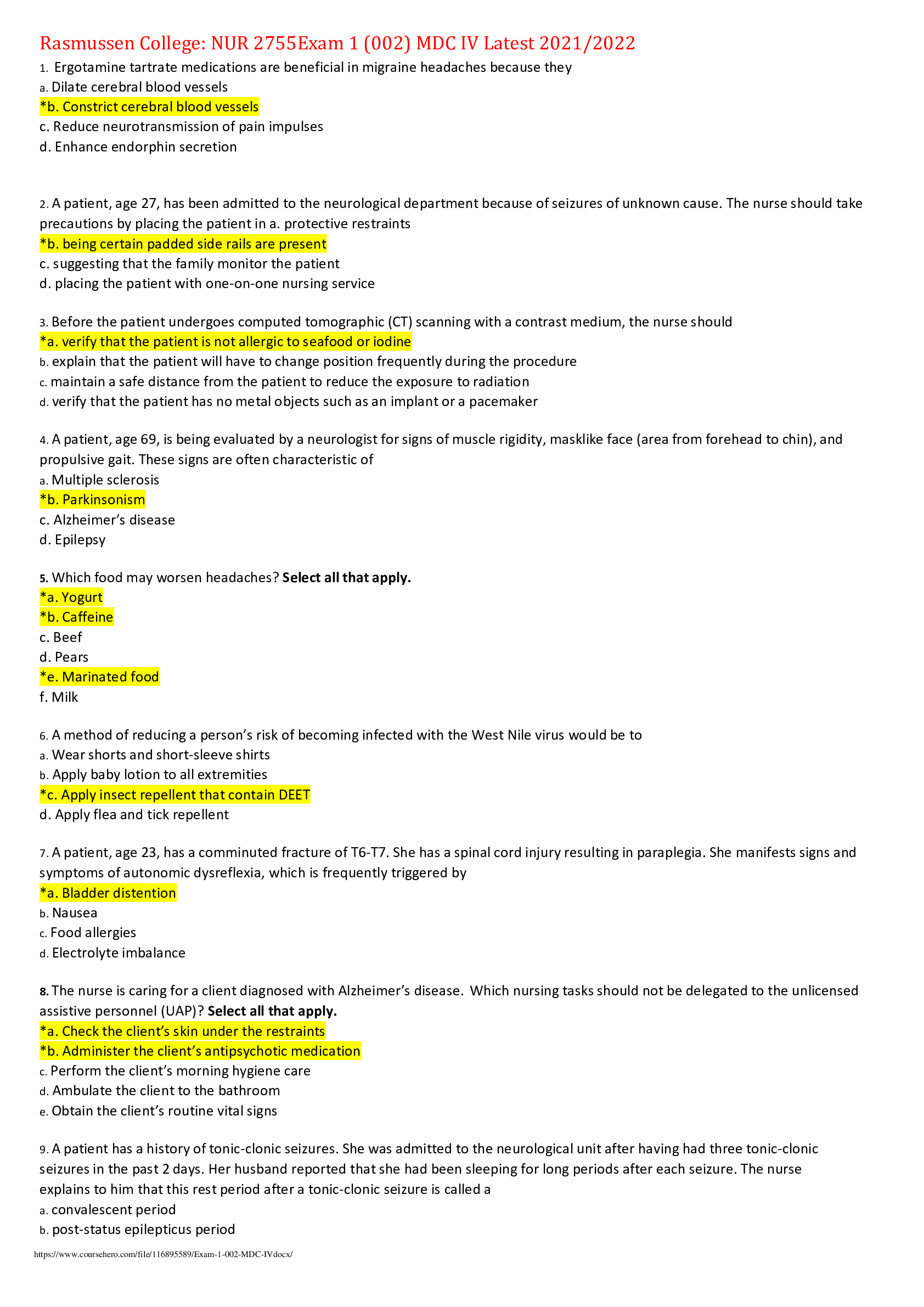
Reviews( 0 )
Document information
Connected school, study & course
About the document
Uploaded On
Feb 12, 2021
Number of pages
5
Written in
Additional information
This document has been written for:
Uploaded
Feb 12, 2021
Downloads
0
Views
48



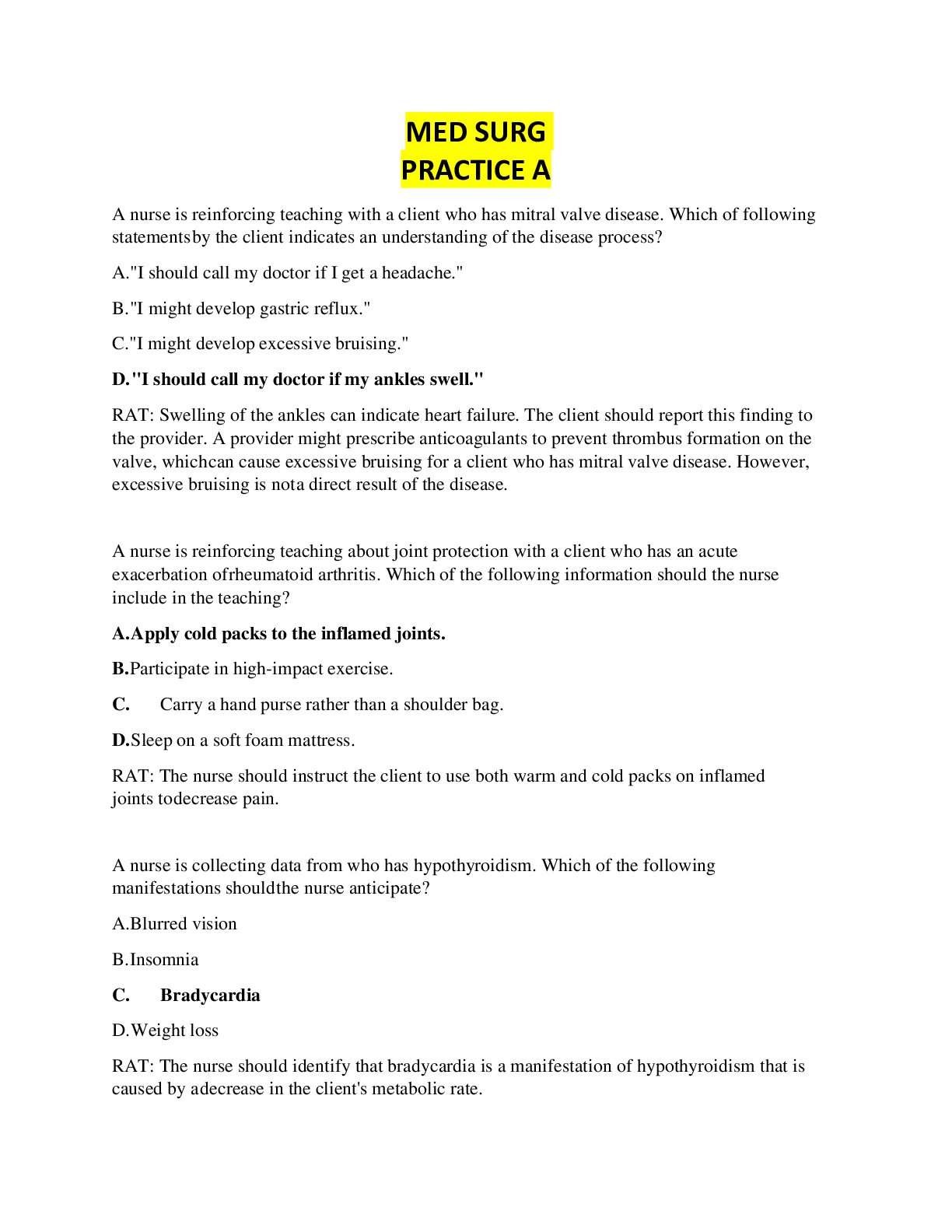


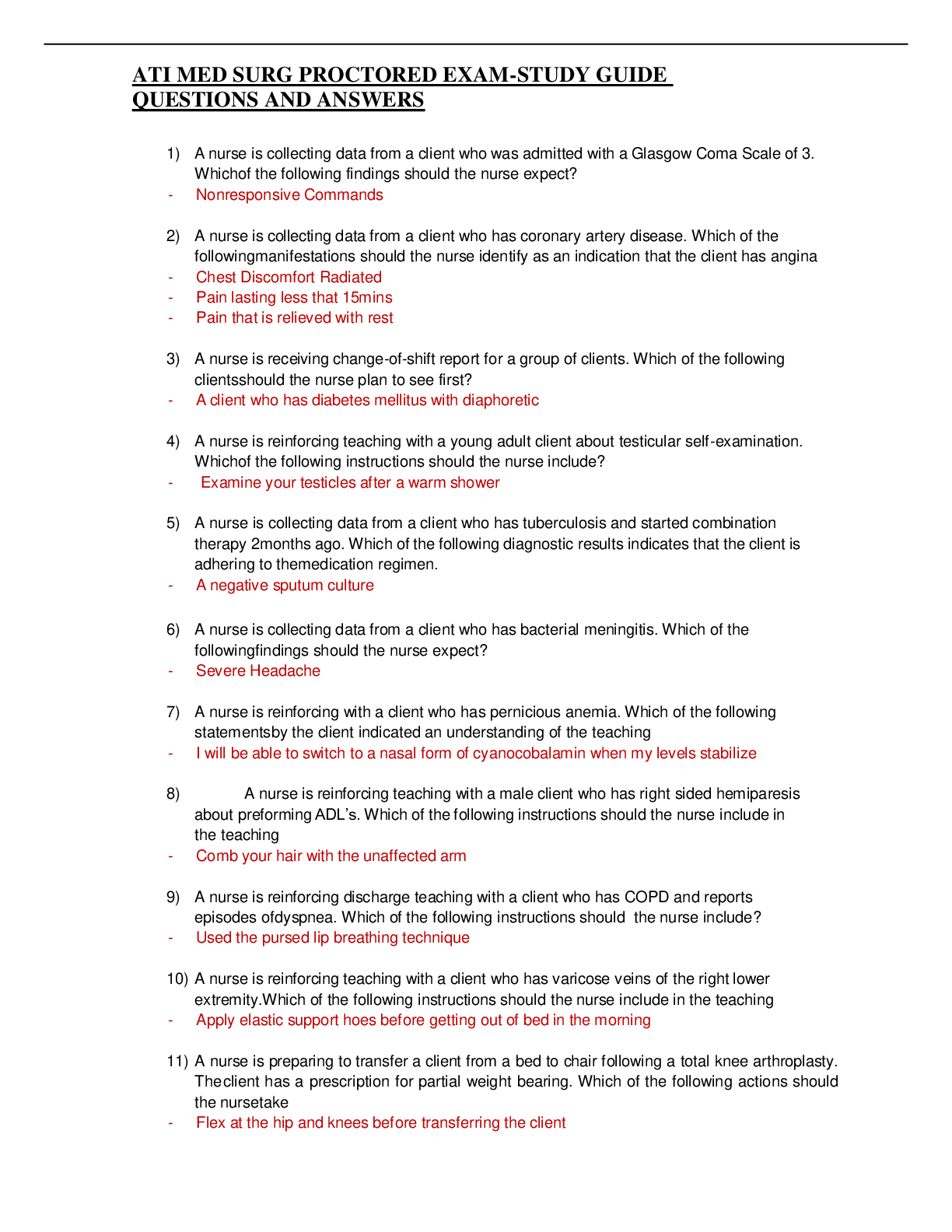
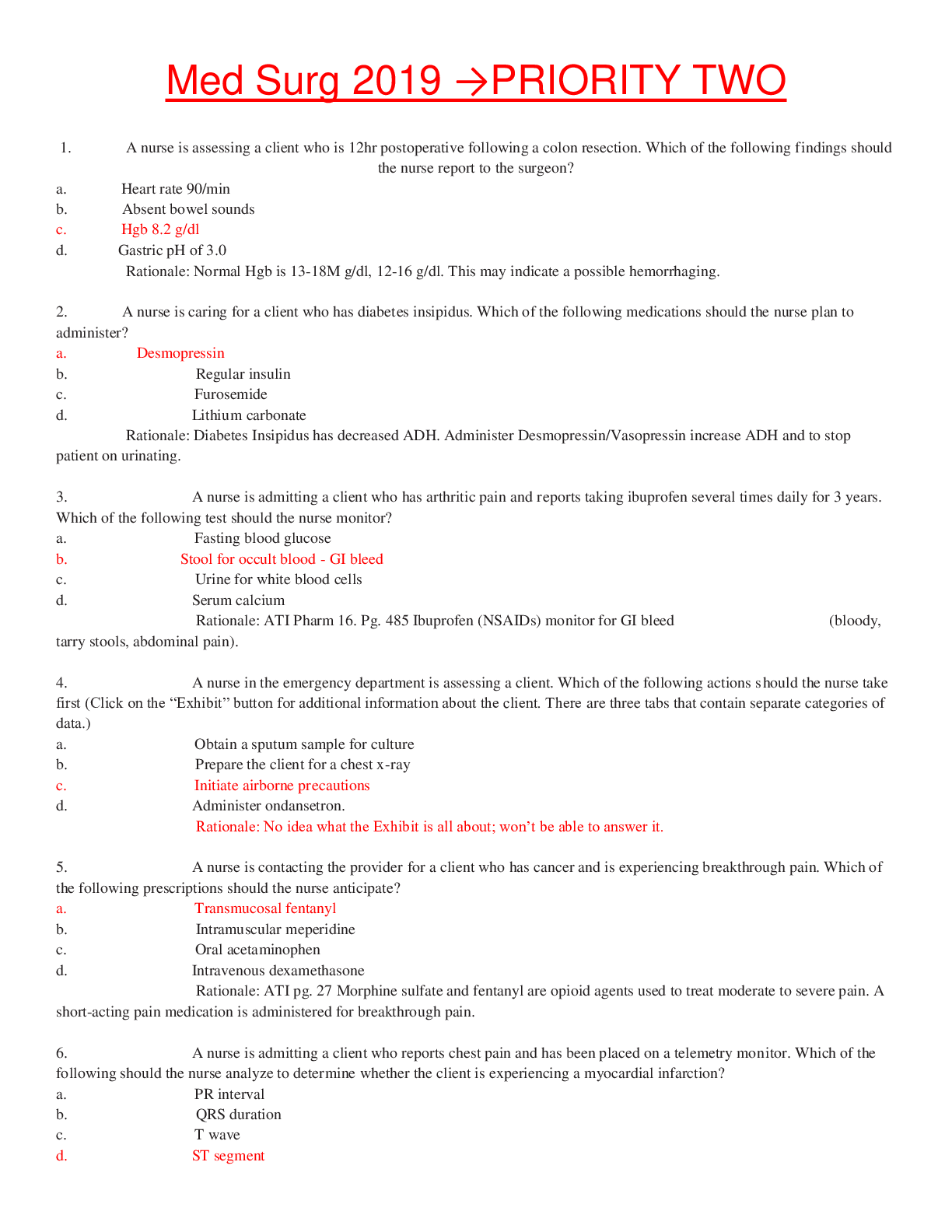

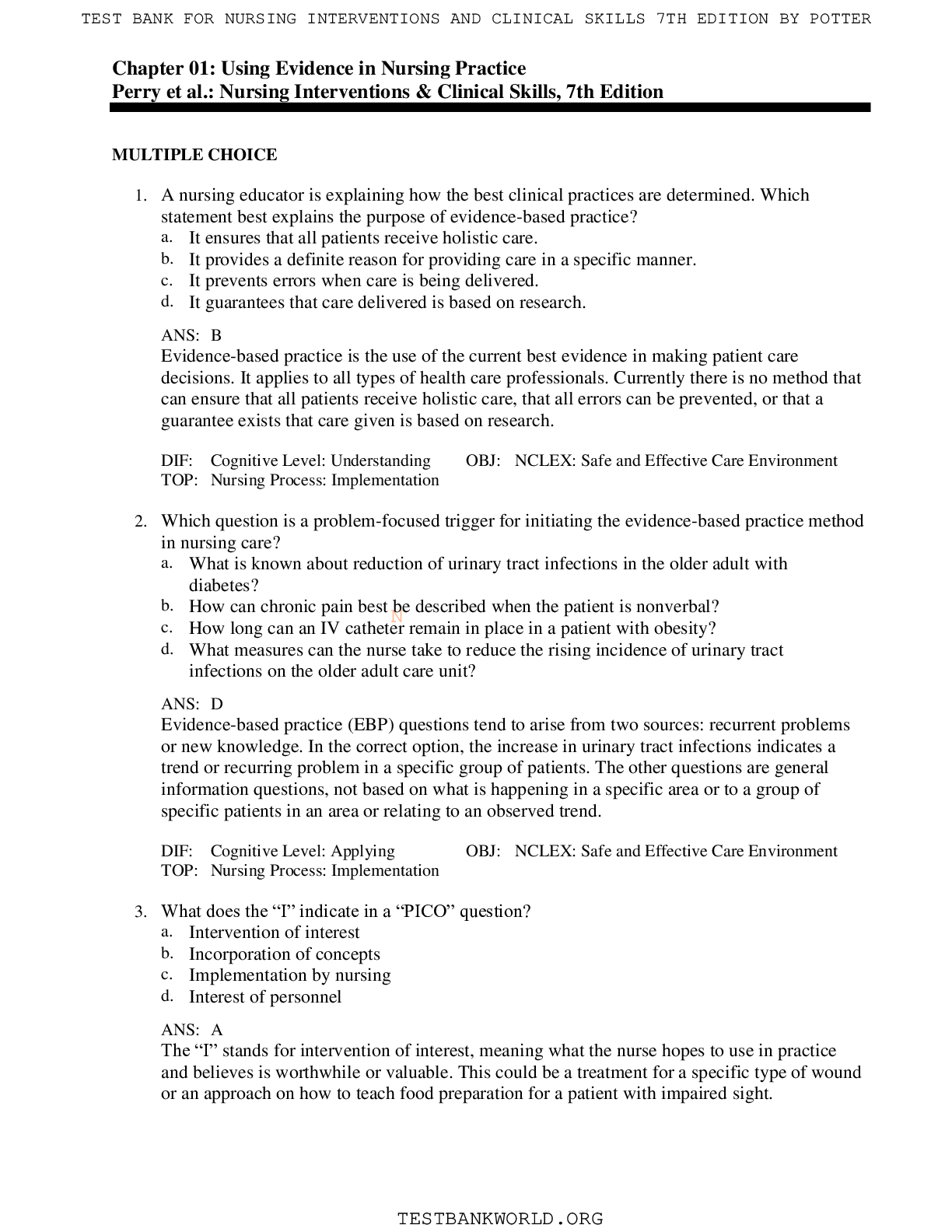
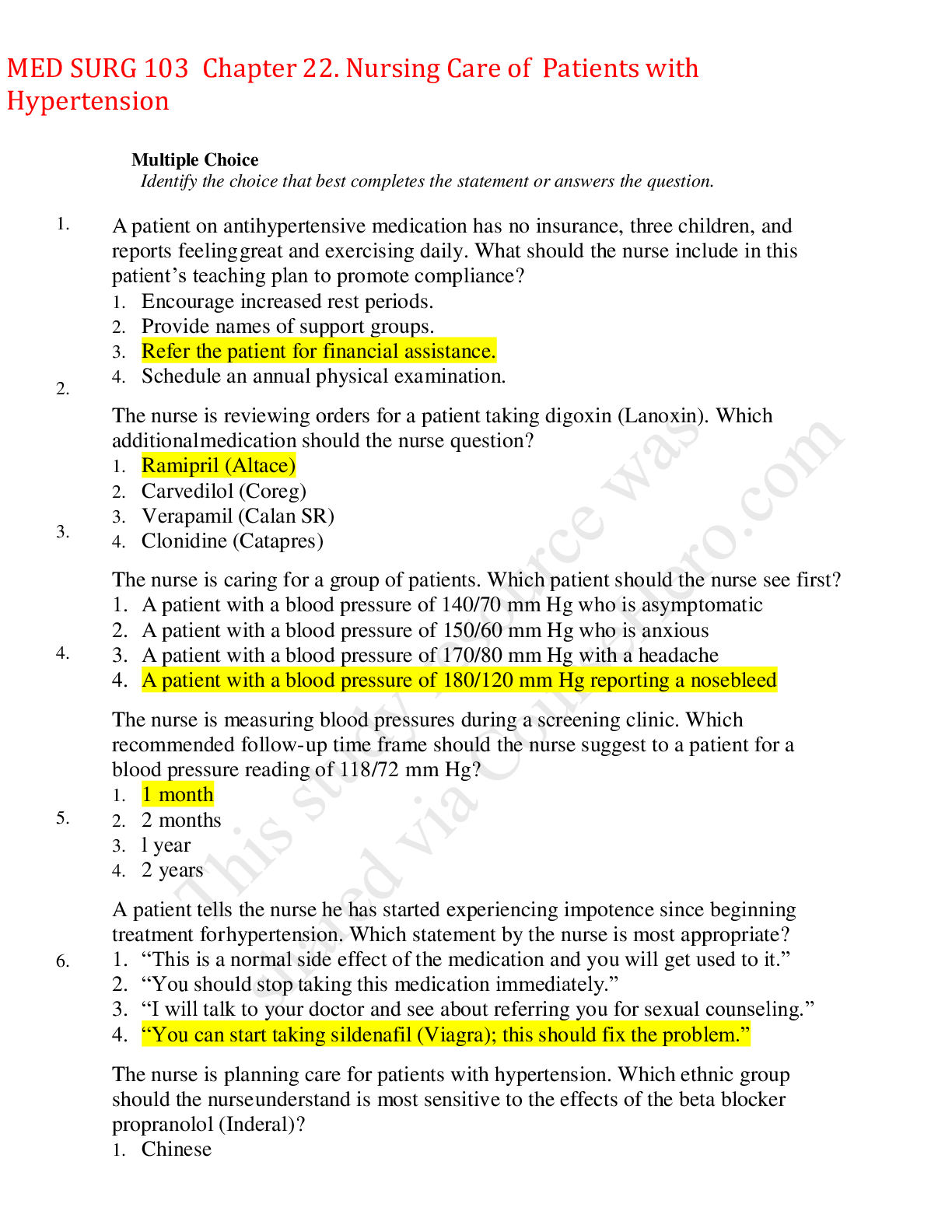

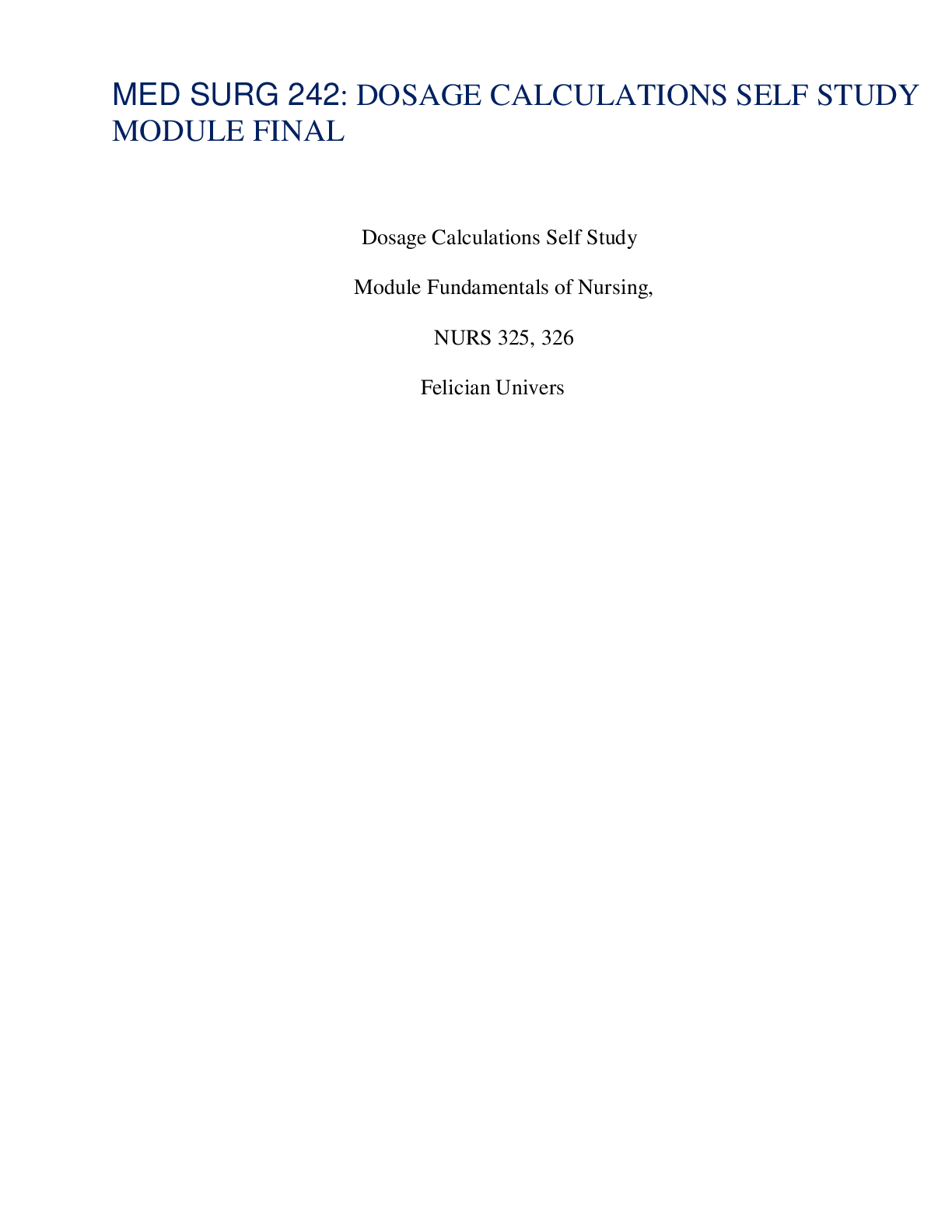

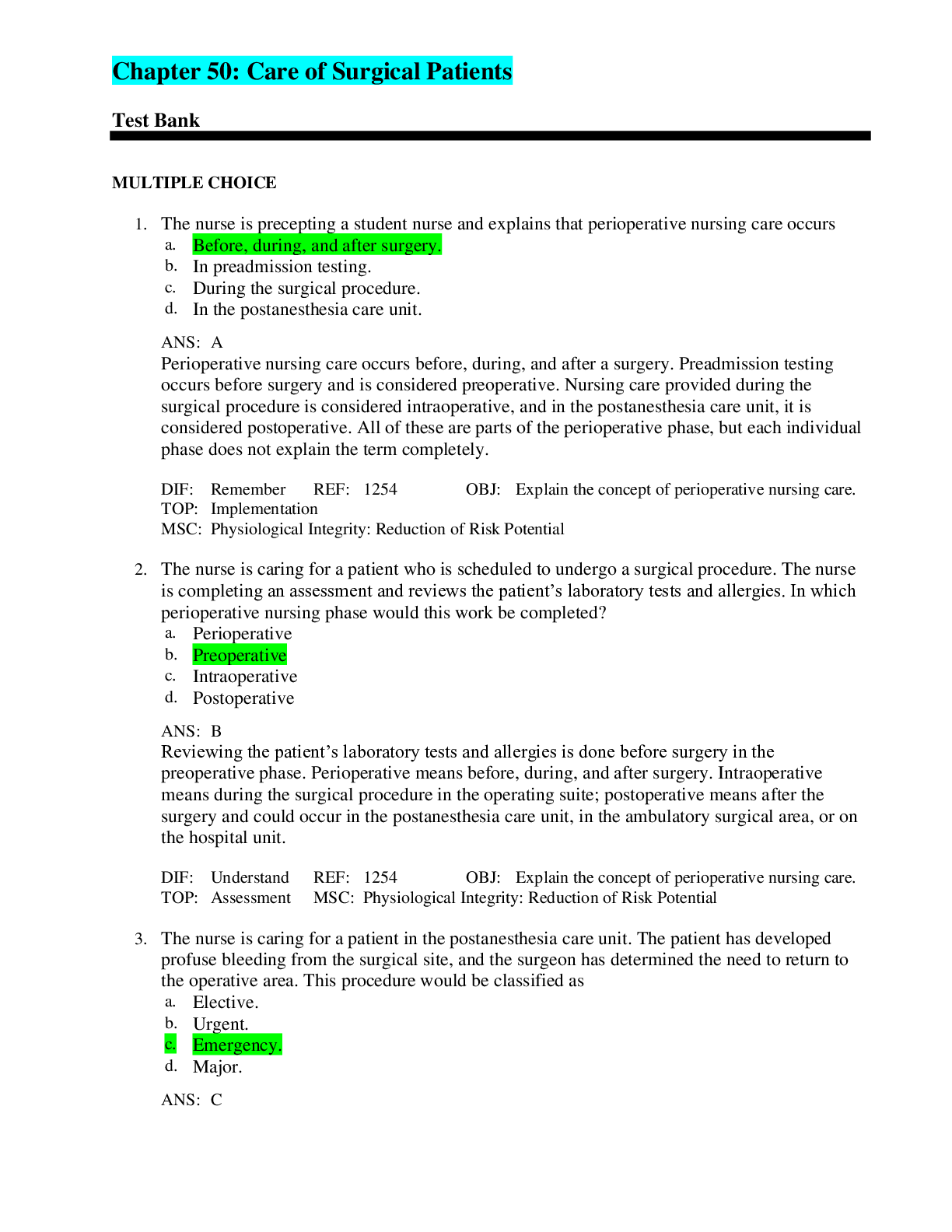

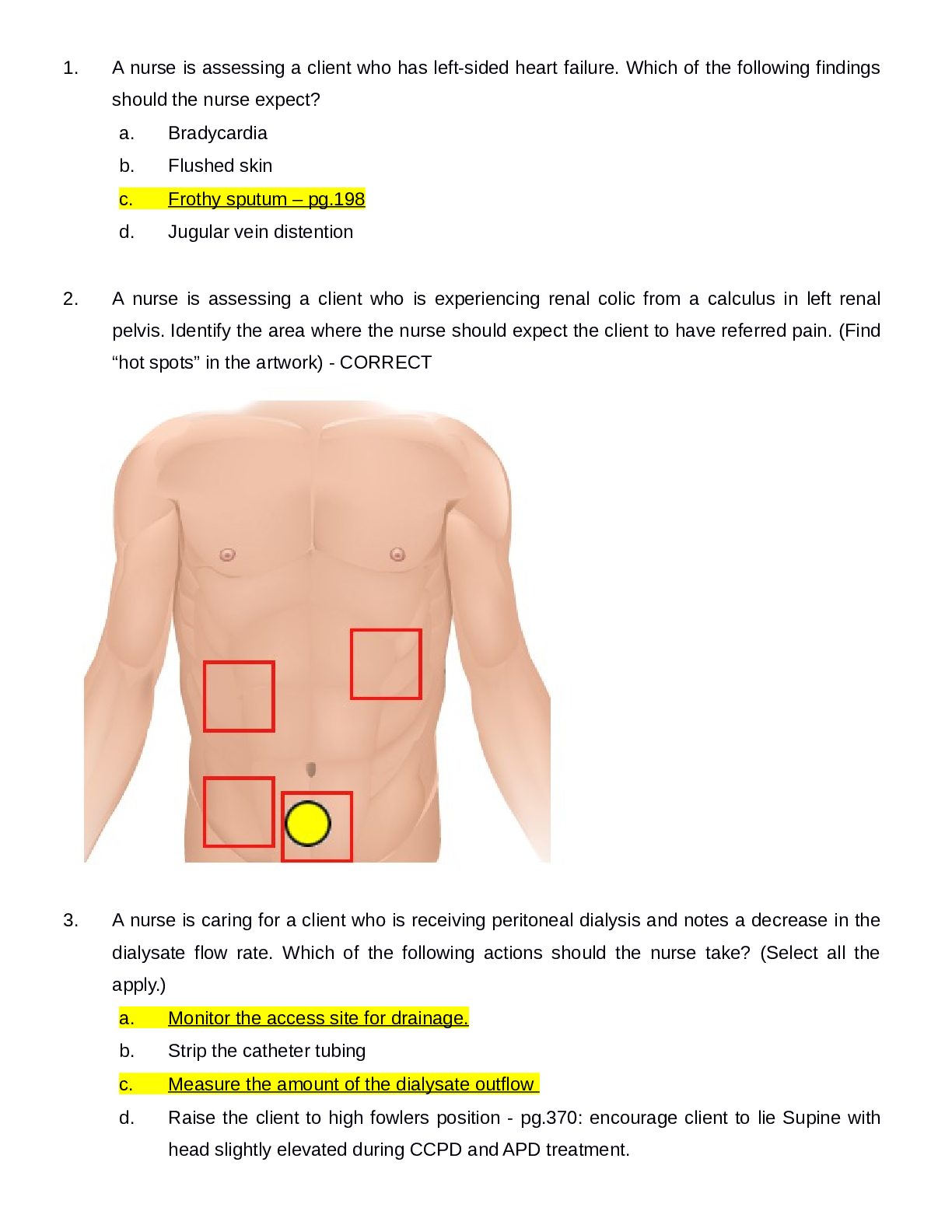
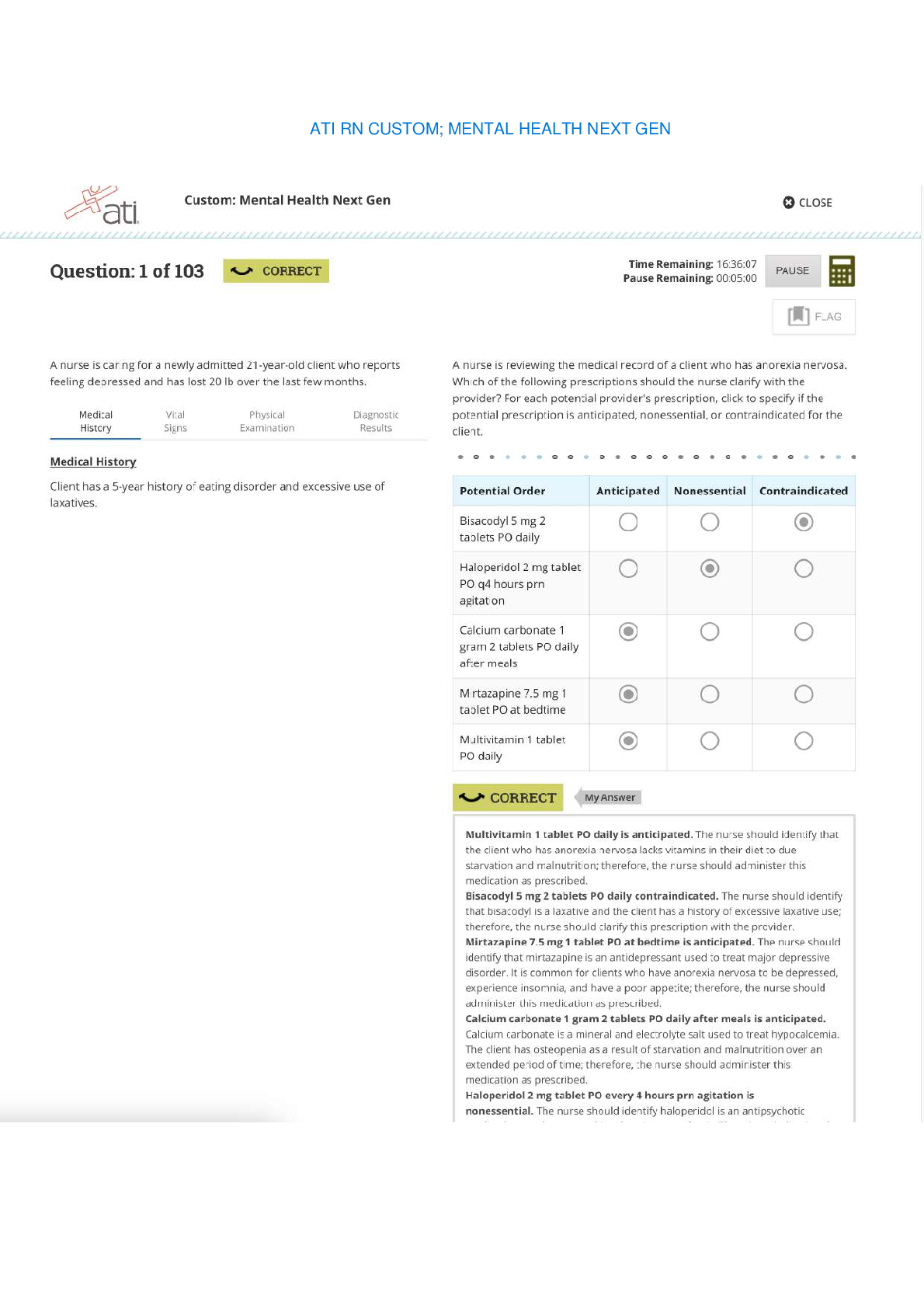
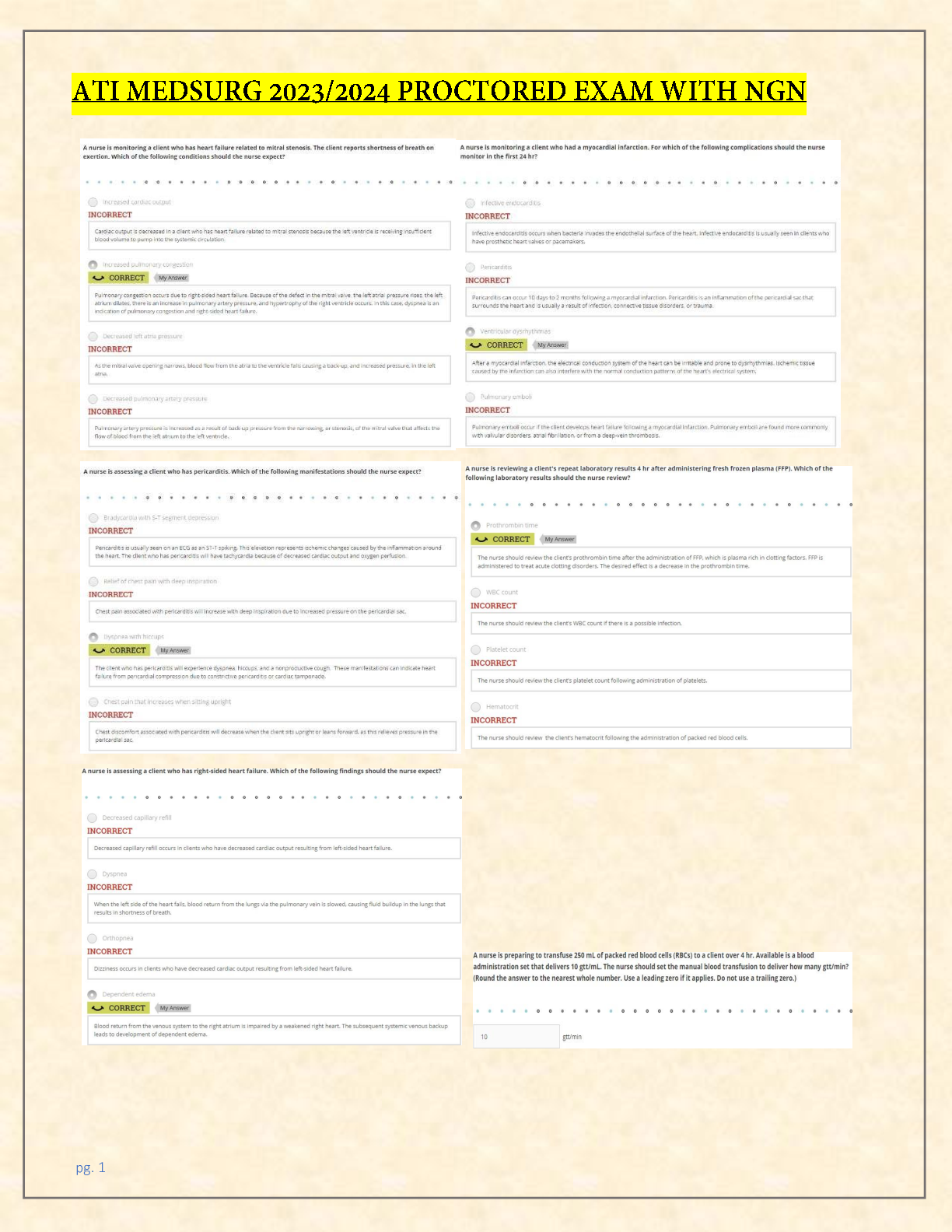
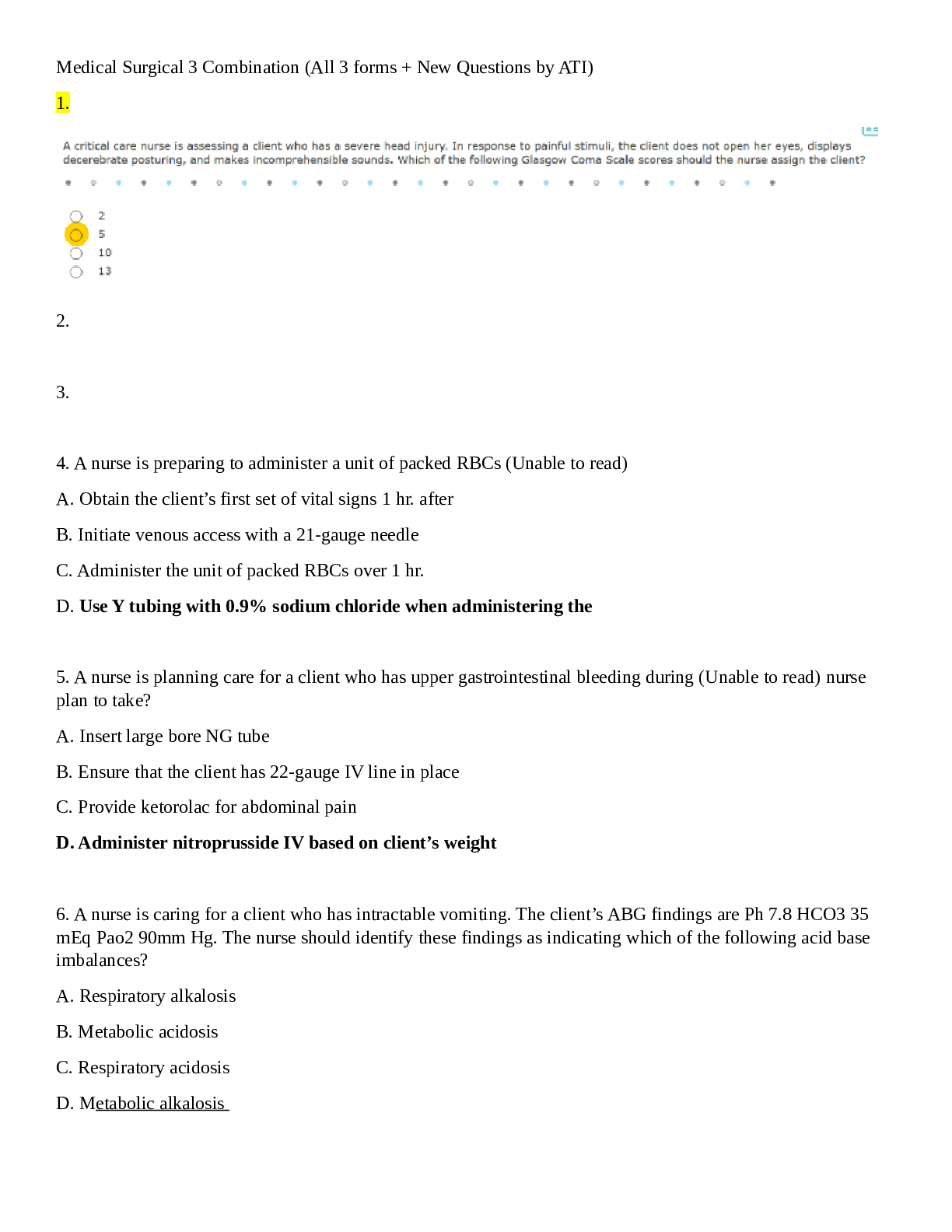
 – Chamberlain College of Nursing.png)

